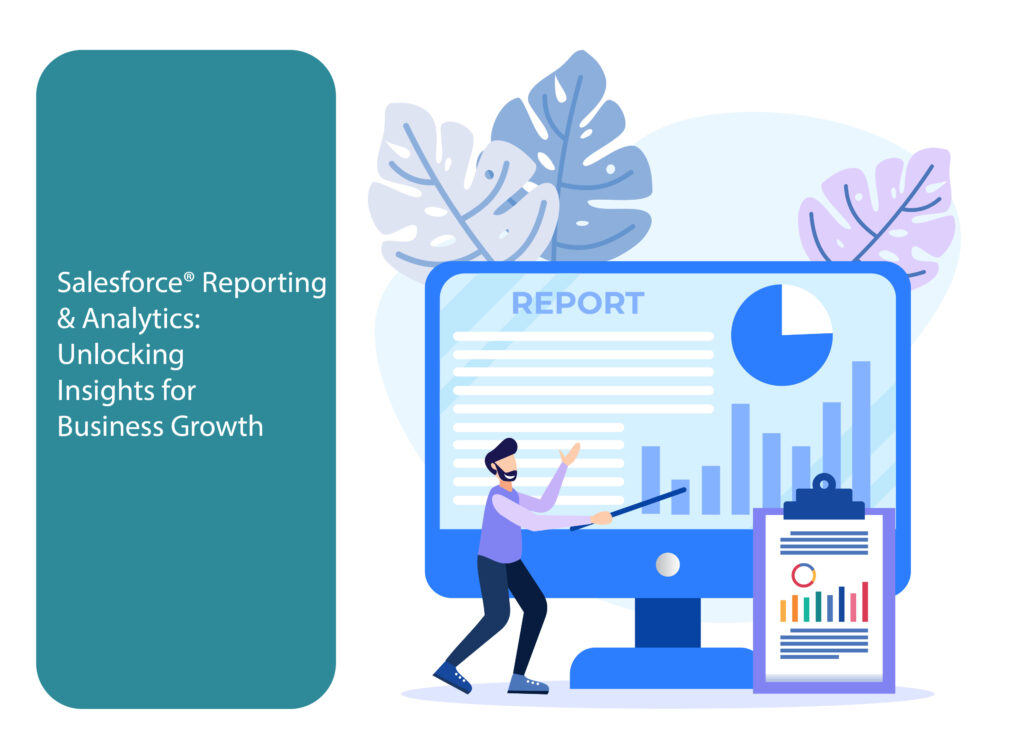Salesforce® Reporting and Analytics: Unlocking Insights for Business Growth

Salesforce® is not just a powerful customer relationship management (CRM) platform, but also a rich source of valuable data that can drive business growth. Salesforce's reporting and analytics capabilities empower organizations to gain actionable insights, make data-driven decisions, and optimize their sales and marketing strategies. In this blog, we will explore how Salesforce reporting and analytics can unlock valuable insights and contribute to your organization's success.
1. Streamlined Data Visualization:
Salesforce offers a robust reporting engine that allows users to create custom reports and dashboards tailored to their specific needs. The intuitive drag-and-drop interface makes it easy to visualize data and present it in meaningful ways. Whether you need to track sales performance, monitor marketing campaigns, or analyze customer trends, Salesforce reporting provides real-time visibility into key metrics, empowering teams to make informed decisions.
2. Customizable Dashboards:
Salesforce's customizable dashboards enable users to create visual representations of their data, providing a consolidated view of critical metrics and KPIs. Dashboards can be tailored to different roles and departments, allowing teams to monitor progress and identify trends at a glance. By presenting data in an easily digestible format, dashboards foster collaboration and help teams align their efforts toward common goals.
3. Ad Hoc Reporting:
In addition to pre-built reports and dashboards, Salesforce allows users to perform ad hoc reporting, enabling on-the-fly data analysis. Ad hoc reporting empowers users to explore data from various angles, apply filters, and drill down into specific details. This flexibility facilitates deeper insights and helps uncover hidden trends and patterns that can inform strategic decision-making.
4. Advanced Analytics with Einstein Analytics:
Salesforce's Einstein Analytics takes reporting to the next level with advanced analytics and artificial intelligence capabilities. Powered by machine learning algorithms, Einstein Analytics automatically analyzes data to identify trends, predict outcomes, and provide actionable recommendations. This enables organizations to proactively address challenges and capitalize on opportunities, driving business growth and efficiency.
5. Integration with External Data Sources:
Salesforce's reporting and analytics capabilities extend beyond native CRM data. By integrating Salesforce with external data sources, such as ERP systems, marketing automation platforms, or customer support systems, organizations can gain a holistic view of their business operations. Combining data from multiple sources provides a comprehensive understanding of customers, processes, and outcomes, enabling data-driven decision-making across the organization.
6. Mobile Reporting:
Salesforce's mobile app ensures that reporting and analytics are accessible on the go. Users can view and interact with reports and dashboards from their mobile devices, empowering them to stay informed and make critical decisions anytime, anywhere. Mobile reporting enables sales teams to access real-time data during customer meetings, managers to monitor team performance on the fly, and executives to stay updated on key business metrics while traveling.
7. Continuous Improvement through Iterative Analysis:
To extract the maximum value from Salesforce reporting and analytics, embrace a culture of continuous improvement. Regularly analyze data, review reports and dashboards, and seek opportunities for optimization. By identifying trends, monitoring progress against goals, and leveraging insights to refine strategies, organizations can iteratively improve their sales, marketing, and customer engagement processes, leading to sustainable business growth.
Conclusion:
Salesforce reporting and analytics empower organizations to unlock valuable insights and drive business growth. By leveraging Salesforce's streamlined data visualization, customizable dashboards, ad hoc reporting, advanced analytics with Einstein, integration with external data sources, mobile reporting, and a culture of continuous improvement, organizations can harness the power of data to make informed decisions, optimize processes, and achieve their business objectives. Embrace the data-driven approach and let Salesforce reporting and analytics be your compass in navigating the path to success.
For Latest News & Update
Want Receive the Best Salesforce Insights? Subscribe Now!
We can help you to create your CRM for better business revenue.